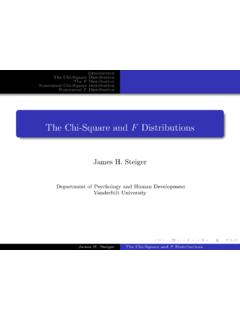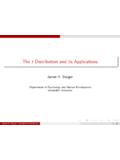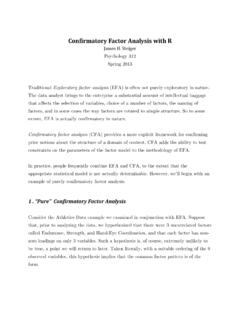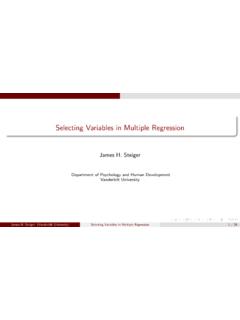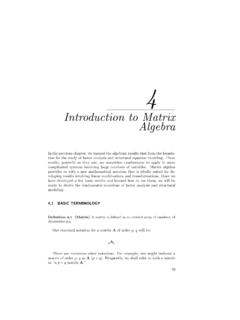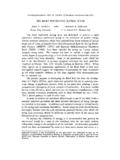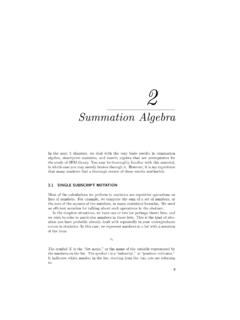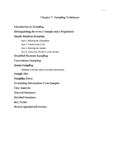Transcription of Tutorial Gpower - Statpower
1 Gpower Tutorial Before we begin this Tutorial , we would like to give you a general advice for performing power analyses. A very frequent error in performing power analyses with G*Power is to specify incorrect degrees of freedom. As a general rule, therefore, we recommend that you routinely compare the degrees of freedom as specified in G*Power with the degrees of freedom that your statistical analysis program gives you for an appropriate set of data. If you do not yet have your data set ( , in the case of an a priori power analysis), then you could simply create an appropriate artificial data set and check the degrees of freedom for this set.
2 Let us now start with the simplest possible case, a t-test for independent samples. In a now-classic study, Warrington and Weiskrantz (1970) compared the memory performance of amnesics to normal controls. Amnesics are persons who have very serious long-term memory problems. It very often takes them weeks to learn where the bathroom is in a new environment, and some of them never seem to learn such things. Perhaps the most intriguing result of the Warrington and Weiskrantz study was that amnesics and normals differed with respect to direct, but not indirect measures of memory. An example of a direct memory measure would be recognition performance.
3 This measure is called direct because the remembering person receives explicit instructions to recollect a prior study episode ("please recognize which of these words you have seen before"). In contrast, word stem completion would be an indirect measure of memory. In such a task, a person is given a word stem such as " " and is asked to complete it with the first word that comes to mind. If the probability of completing such stems with studied words is above base-line, then we observe an effect of prior experience. It should be clear by now why the finding of no statistically significant difference between amnesiacs and normal in indirect tests was so exciting: All of a sudden there was evidence for memory where it was not expected, but only when the instructions did not stress the fact that the task was a memory task.
4 However, it may appear a bit puzzling that amnesiacs and normal were not totally equivalent with respect to the indirect word stem completion task. Rather, normal were a bit better than amnesiacs with an average of 16 versus stems completed with studied words, respectively. Of course, in the recognition task, normal were much better than amnesiacs with correct recognition scores of 13 versus 8, respectively. At this point, one may wonder about the power of the relevant statistical test to detect a difference if there truly was one. Therefore, let's perform a post-hoc power analysis on these Warrington and Weiskrantz (1970) data.
5 Post-hoc Power Analysis For the sake of this example, let us assume that the mean word-stem completion performance for amnesics ( ) and normals (16) as observed by Warrington and Weiskrantz (1970) reflects the population means, and let the population standard deviation of both group means be sigma = 3. We can now compute the effect size index d (Cohen, 1977) which is defined as 21 =d We obtain =d The resulting d = can be interpreted as a "medium" effect according to Cohen's (1977) popular effect size conventions. A total of n1 = 4 amnesics and n2 = 8 normal control subjects participated in the Warrington and Weiskrantz (1970) study.
6 These sample sizes are used by G*Power to compute the relevant noncentrality parameter of the noncentral t-distribution. The noncentral distribution of a test statistic results, for a certain sample size, if H1 (the alternative hypothesis) is true. The noncentrality parameter delta ( ) is defined as 2121nnnnd+= Now we are almost set to perform our post-hoc power analysis. One more piece is missing, however. We need to decide which level of alpha is acceptable. Without much thinking, we choose alpha = .05. Given these premises, what was the power in the Warrington and Weiskrantz (1970) study to detect a "medium" size difference between amnesics and controls in the word stem completion task?
7 Start G*Power and select: Type of Power Analysis: Post-hoc Type of Test: t-Test (means), two-tailed Accuracy mode calculation Next, G*Power needs the following input: Alpha: .05 Effect size "d": n1: n2: 4 8 You can now press the Calculate button and observe the following result: Power (1-beta): Critical t: t(10) = Delta: This result is devastating: The relevant statistical test had virtually no power to detect a "medium" size difference between amnesics and controls in the word stem completion task. If we were to repeat the Warrington and Weiskrantz (1970) study with more statistical power, how many participants would we need?
8 This question is answered by an A Priori Power Analysis In an a priori power analysis, we know which alpha and beta levels we can accept, and ideally we also have a good idea of the size of the effect which we want to detect. We decide to be maximally idealistic and choose alpha = beta = .05. (It means a power level of 1- = ). In addition, we know that the size of the effect we want to detect is d = We are now ready to perform our a priori power analysis. Select: Type of Power Analysis: A priori Type of Test: t-Test (means), two-tailed Accuracy mode calculation Input: Alpha: .05 Power (1-beta).
9 95 Effect size "d": Result: Total sample size: 210 Actual power: Critical t: t(208) = Delta: We are shocked. Obviously, there is no way we can recruit N = 210 subjects for our study, simply because it would be impossible to find n1 = 105 amnesic patients (fortunately, very few people suffer from severe amnesia!). Assume that we work in a hospital in which n1 = 20 amnesics are treated at the moment. It seems reasonable to expect that we can recruit an equal number of control patients to participate in our study. Thus, n1 + n2 = 20 + 20 = 40 is our largest possible sample size. What are we going to do?
10 Well, we simply perform a Compromise Power Analysis Erdfelder (1984) has developed the concept of a compromise power analysis specifically for cases like the present one in which pragmatic constraints prohibit that our investigations follow the recommendations derived from an a priori power analysis. The basic idea here is that two things are fixed, the maximum possible sample size and the effect we want to detect, but that we may still opt to choose alpha and beta error probabilities in accordance with the other two parameters. All we need to specify is the relative seriousness of the alpha and beta error probabilities.
